#middleware components
Explore tagged Tumblr posts
Text
Event-Driven Design Demystified: Concepts and Examples
🚀 Discover how this cutting-edge architecture transforms software systems with real-world examples. From e-commerce efficiency to smart home automation, learn how to create responsive and scalable applications #EventDrivenDesign #SoftwareArchitecture
In the world of software architecture, event-driven design has emerged as a powerful paradigm that allows systems to react and respond to events in a flexible and efficient manner. Whether you’re building applications, microservices, or even IoT devices, understanding event-driven design can lead to more scalable, responsive, and adaptable systems. In this article, we’ll delve into the core…

View On WordPress
#Asynchronous Communication#Decoupling Components#E-commerce Order Processing#Event Broker Paradigm#Event Sources and Consumers#Event-driven architecture#Event-Driven Examples#Event-Driven Paradigm#Event-Triggered Workflows#Microservices and Events#Middleware in Event-Driven Design#Modular Development#Reactive Systems#Real-Time Responsiveness#Scalable Software Systems#Smart Home Automation#Social Media Notifications#Software Design Patterns#System Event Handling#User Experience Enhancement
1 note
·
View note
Text
How-To IT
Topic: Core areas of IT
1. Hardware
• Computers (Desktops, Laptops, Workstations)
• Servers and Data Centers
• Networking Devices (Routers, Switches, Modems)
• Storage Devices (HDDs, SSDs, NAS)
• Peripheral Devices (Printers, Scanners, Monitors)
2. Software
• Operating Systems (Windows, Linux, macOS)
• Application Software (Office Suites, ERP, CRM)
• Development Software (IDEs, Code Libraries, APIs)
• Middleware (Integration Tools)
• Security Software (Antivirus, Firewalls, SIEM)
3. Networking and Telecommunications
• LAN/WAN Infrastructure
• Wireless Networking (Wi-Fi, 5G)
• VPNs (Virtual Private Networks)
• Communication Systems (VoIP, Email Servers)
• Internet Services
4. Data Management
• Databases (SQL, NoSQL)
• Data Warehousing
• Big Data Technologies (Hadoop, Spark)
• Backup and Recovery Systems
• Data Integration Tools
5. Cybersecurity
• Network Security
• Endpoint Protection
• Identity and Access Management (IAM)
• Threat Detection and Incident Response
• Encryption and Data Privacy
6. Software Development
• Front-End Development (UI/UX Design)
• Back-End Development
• DevOps and CI/CD Pipelines
• Mobile App Development
• Cloud-Native Development
7. Cloud Computing
• Infrastructure as a Service (IaaS)
• Platform as a Service (PaaS)
• Software as a Service (SaaS)
• Serverless Computing
• Cloud Storage and Management
8. IT Support and Services
• Help Desk Support
• IT Service Management (ITSM)
• System Administration
• Hardware and Software Troubleshooting
• End-User Training
9. Artificial Intelligence and Machine Learning
• AI Algorithms and Frameworks
• Natural Language Processing (NLP)
• Computer Vision
• Robotics
• Predictive Analytics
10. Business Intelligence and Analytics
• Reporting Tools (Tableau, Power BI)
• Data Visualization
• Business Analytics Platforms
• Predictive Modeling
11. Internet of Things (IoT)
• IoT Devices and Sensors
• IoT Platforms
• Edge Computing
• Smart Systems (Homes, Cities, Vehicles)
12. Enterprise Systems
• Enterprise Resource Planning (ERP)
• Customer Relationship Management (CRM)
• Human Resource Management Systems (HRMS)
• Supply Chain Management Systems
13. IT Governance and Compliance
• ITIL (Information Technology Infrastructure Library)
• COBIT (Control Objectives for Information Technologies)
• ISO/IEC Standards
• Regulatory Compliance (GDPR, HIPAA, SOX)
14. Emerging Technologies
• Blockchain
• Quantum Computing
• Augmented Reality (AR) and Virtual Reality (VR)
• 3D Printing
• Digital Twins
15. IT Project Management
• Agile, Scrum, and Kanban
• Waterfall Methodology
• Resource Allocation
• Risk Management
16. IT Infrastructure
• Data Centers
• Virtualization (VMware, Hyper-V)
• Disaster Recovery Planning
• Load Balancing
17. IT Education and Certifications
• Vendor Certifications (Microsoft, Cisco, AWS)
• Training and Development Programs
• Online Learning Platforms
18. IT Operations and Monitoring
• Performance Monitoring (APM, Network Monitoring)
• IT Asset Management
• Event and Incident Management
19. Software Testing
• Manual Testing: Human testers evaluate software by executing test cases without using automation tools.
• Automated Testing: Use of testing tools (e.g., Selenium, JUnit) to run automated scripts and check software behavior.
• Functional Testing: Validating that the software performs its intended functions.
• Non-Functional Testing: Assessing non-functional aspects such as performance, usability, and security.
• Unit Testing: Testing individual components or units of code for correctness.
• Integration Testing: Ensuring that different modules or systems work together as expected.
• System Testing: Verifying the complete software system’s behavior against requirements.
• Acceptance Testing: Conducting tests to confirm that the software meets business requirements (including UAT - User Acceptance Testing).
• Regression Testing: Ensuring that new changes or features do not negatively affect existing functionalities.
• Performance Testing: Testing software performance under various conditions (load, stress, scalability).
• Security Testing: Identifying vulnerabilities and assessing the software’s ability to protect data.
• Compatibility Testing: Ensuring the software works on different operating systems, browsers, or devices.
• Continuous Testing: Integrating testing into the development lifecycle to provide quick feedback and minimize bugs.
• Test Automation Frameworks: Tools and structures used to automate testing processes (e.g., TestNG, Appium).
19. VoIP (Voice over IP)
VoIP Protocols & Standards
• SIP (Session Initiation Protocol)
• H.323
• RTP (Real-Time Transport Protocol)
• MGCP (Media Gateway Control Protocol)
VoIP Hardware
• IP Phones (Desk Phones, Mobile Clients)
• VoIP Gateways
• Analog Telephone Adapters (ATAs)
• VoIP Servers
• Network Switches/ Routers for VoIP
VoIP Software
• Softphones (e.g., Zoiper, X-Lite)
• PBX (Private Branch Exchange) Systems
• VoIP Management Software
• Call Center Solutions (e.g., Asterisk, 3CX)
VoIP Network Infrastructure
• Quality of Service (QoS) Configuration
• VPNs (Virtual Private Networks) for VoIP
• VoIP Traffic Shaping & Bandwidth Management
• Firewall and Security Configurations for VoIP
• Network Monitoring & Optimization Tools
VoIP Security
• Encryption (SRTP, TLS)
• Authentication and Authorization
• Firewall & Intrusion Detection Systems
• VoIP Fraud DetectionVoIP Providers
• Hosted VoIP Services (e.g., RingCentral, Vonage)
• SIP Trunking Providers
• PBX Hosting & Managed Services
VoIP Quality and Testing
• Call Quality Monitoring
• Latency, Jitter, and Packet Loss Testing
• VoIP Performance Metrics and Reporting Tools
• User Acceptance Testing (UAT) for VoIP Systems
Integration with Other Systems
• CRM Integration (e.g., Salesforce with VoIP)
• Unified Communications (UC) Solutions
• Contact Center Integration
• Email, Chat, and Video Communication Integration
2 notes
·
View notes
Text
Certainly! Let’s explore how to build a full-stack application using Node.js. In this comprehensive guide, we’ll cover the essential components and steps involved in creating a full-stack web application.
Building a Full-Stack Application with Node.js, Express, and MongoDB
1. Node.js: The Backbone of Our Application
Node.js is a runtime environment that allows us to run JavaScript on the server-side.
It’s built on Chrome’s V8 JavaScript engine and uses an event-driven, non-blocking I/O model, making it lightweight and efficient.
Node.js serves as the backbone of our application, providing the environment in which our server-side code will run.
2. Express.js: Simplifying Server-Side Development
Express.js is a minimal and flexible Node.js web application framework.
It provides a robust set of features for building web and mobile applications.
With Express.js, we can:
Set up middlewares to respond to HTTP requests.
Define routing rules.
Add additional features like template engines.
3. MongoDB: Storing Our Data
MongoDB is a document-oriented database program.
It uses JSON-like documents with optional schemas and is known for its flexibility and scalability.
We’ll use MongoDB to store our application’s data in an accessible and writable format.
Building Our Full-Stack Application: A Step-by-Step Guide
Setting Up the Environment:
Install Node.js:sudo apt install nodejs
Initialize a new Node.js project:mkdir myapp && cd myapp npm init -y
Install Express.js:npm install express
Creating the Server:
Create a basic Express server:const express = require('express'); const app = express(); const port = 3000; app.get('/', (req, res) => { res.send('Hello World!'); }); app.listen(port, () => { console.log(`Server running at http://localhost:${port}`); });
Defining Routes:
Define routes for different parts of our application:app.get('/user', (req, res) => { res.send('User Page'); });
Connecting to MongoDB:
Use Mongoose (a MongoDB object modeling tool) to connect to MongoDB and handle data storage.
Remember, this is just the beginning! Full-stack development involves frontend (client-side) work as well. You can use React, Angular, or other frontend libraries to build the user interface and connect it to your backend (Node.js and Express).
Feel free to explore more about each component and dive deeper into building your full-stack application! 😊 12
2 notes
·
View notes
Text
SAP Basis

SAP Basis: The Backbone of Your SAP Landscape
SAP applications form the core of many modern enterprises. Financial data, customer interactions, supply chain logistics, and many other critical business operations rely on SAP’s robust solutions. But what powers these solutions? That’s where SAP Basis comes in.
What is SAP Basis?
In simple terms, SAP Basis is the technological foundation upon which SAP applications are built and run. It’s like the operating system specifically for your SAP world. Basis provides a set of middleware components and administration tools that ensure your SAP applications function smoothly and reliably.
Key Responsibilities of an SAP Basis Administrator
SAP Basis administrators are the unsung heroes of the SAP world, responsible for a wide range of tasks:
Installation and Configuration: Basis admins handle the initial installation and setup of SAP systems, ensuring they’re configured correctly for your business needs.
System Administration: They perform ongoing tasks like monitoring system health, applying patches and upgrades, and managing system resources.
Database Management: This includes database installation, configuration, backup and restore processes, and overall database health.
Performance Tuning: Basis admins identify bottlenecks, optimize settings, and ensure applications run at their peak.
User Management: Creating and managing user accounts, assigning roles and authorizations for secure access control.
Troubleshooting: When problems arise, these experts step up to diagnose and resolve issues promptly, minimizing downtime for the business.
Transport Management: They oversee the movement of code changes and configuration updates between different SAP environments (e.g., development, testing, production).
Components of SAP Basis
Some core components that make up SAP Basis include:
SAP NetWeaver: The core technology platform that provides the foundation for different SAP products.
ABAP Workbench: The development environment for creating custom ABAP code (SAP’s primary programming language).
SAP GUI: The graphical user interface used to interact with SAP systems.
Transport Management System: Tools for managing and tracking changes across SAP environments.
Solution Manager: A centralized platform for system monitoring, diagnostics, and support tools.
Why is SAP Basis Important?
Reliability and Stability: A well-managed SAP Basis system means your critical business applications will run smoothly, minimizing disruptions and downtime.
Performance: Basis expertise ensures that your SAP applications are optimized to deliver their best, promoting efficient business operations.
Security: Basis includes a suite of tools to manage user access, protect sensitive data, and ensure compliance with security standards.
Agility: A flexible Basis layer gives your business the ability to adapt to changing needs by scaling SAP deployments or introducing new components.
Becoming an SAP Basis Administrator
A career in SAP Basis is both challenging and rewarding. If you have a knack for technical troubleshooting, problem-solving, and enjoy working with complex systems, here’s how to get started:
Get a Technical Foundation: A background in computer science, database administration, or system administration is a strong starting point.
Gain SAP Expertise: Take SAP Basis training courses and explore online resources and tutorials.
Certifications: Consider getting SAP-certified in Basis administration to validate your skills.
Hands-on Experience: Look for internship or entry-level positions that allow you to work on real SAP systems.
The Future of SAP Basis
As SAP continues to evolve into a cloud-centric platform, Basis will adapt too. Knowledge of cloud technologies, containerization, and automation will become increasingly valuable for Basis administrators.
youtube
You can find more information about SAP BASIS in this SAP BASIS Link
Conclusion:
Unogeeks is the №1 IT Training Institute for SAP BASIS Training. Anyone Disagree? Please drop in a comment
You can check out our other latest blogs on SAP BASIS here — SAP BASIS Blogs
You can check out our Best In Class SAP BASIS Details here — SAP BASIS Training
Follow & Connect with us:
— — — — — — — — — — — -
For Training inquiries:
Call/Whatsapp: +91 73960 33555
Mail us at: [email protected]
Our Website ➜ https://unogeeks.com
Follow us:
Instagram: https://www.instagram.com/unogeeks
Facebook: https://www.facebook.com/UnogeeksSoftwareTrainingInstitute
Twitter: https://twitter.com/unogeek
2 notes
·
View notes
Text
Top 10 Laravel Development Companies in the USA in 2024
Laravel is a widely-used open-source PHP web framework designed for creating web applications using the model-view-controller (MVC) architectural pattern. It offers developers a structured and expressive syntax, as well as a variety of built-in features and tools to enhance the efficiency and enjoyment of the development process.

Key components of Laravel include:
1. Eloquent ORM (Object-Relational Mapping): Laravel simplifies database interactions by enabling developers to work with database records as objects through a powerful ORM.
2. Routing: Laravel provides a straightforward and expressive method for defining application routes, simplifying the handling of incoming HTTP requests.
3. Middleware: This feature allows for the filtering of HTTP requests entering the application, making it useful for tasks like authentication, logging, and CSRF protection.
4. Artisan CLI (Command Line Interface): Laravel comes with Artisan, a robust command-line tool that offers commands for tasks such as database migrations, seeding, and generating boilerplate code.
5. Database Migrations and Seeding: Laravel's migration system enables version control of the database schema and easy sharing of changes across the team. Seeding allows for populating the database with test data.
6. Queue Management: Laravel's queue system permits deferred or background processing of tasks, which can enhance application performance and responsiveness.
7. Task Scheduling: Laravel provides a convenient way to define scheduled tasks within the application.
What are the reasons to opt for Laravel Web Development?
Laravel makes web development easier, developers more productive, and web applications more secure and scalable, making it one of the most important frameworks in web development.
There are multiple compelling reasons to choose Laravel for web development:
1. Clean and Organized Code: Laravel provides a sleek and expressive syntax, making writing and maintaining code simple. Its well-structured architecture follows the MVC pattern, enhancing code readability and maintainability.
2. Extensive Feature Set: Laravel comes with a wide range of built-in features and tools, including authentication, routing, caching, and session management.
3. Rapid Development: With built-in templates, ORM (Object-Relational Mapping), and powerful CLI (Command Line Interface) tools, Laravel empowers developers to build web applications quickly and efficiently.
4. Robust Security Measures: Laravel incorporates various security features such as encryption, CSRF (Cross-Site Request Forgery) protection, authentication, and authorization mechanisms.
5. Thriving Community and Ecosystem: Laravel boasts a large and active community of developers who provide extensive documentation, tutorials, and forums for support.
6. Database Management: Laravel's migration system allows developers to manage database schemas effortlessly, enabling version control and easy sharing of database changes across teams. Seeders facilitate the seeding of databases with test data, streamlining the testing and development process.
7. Comprehensive Testing Support: Laravel offers robust testing support, including integration with PHPUnit for writing unit and feature tests. It ensures that applications are thoroughly tested and reliable, reducing the risk of bugs and issues in production.
8. Scalability and Performance: Laravel provides scalability options such as database sharding, queue management, and caching mechanisms. These features enable applications to handle increased traffic and scale effectively.
Top 10 Laravel Development Companies in the USA in 2024
The Laravel framework is widely utilised by top Laravel development companies. It stands out among other web application development frameworks due to its advanced features and development tools that expedite web development. Therefore, this article aims to provide a list of the top 10 Laravel Development Companies in 2024, assisting you in selecting a suitable Laravel development company in the USA for your project.
IBR Infotech

IBR Infotech excels in providing high-quality Laravel web development services through its team of skilled Laravel developers. Enhance your online visibility with their committed Laravel development team, which is prepared to turn your ideas into reality accurately and effectively. Count on their top-notch services to receive the best as they customise solutions to your business requirements. Being a well-known Laravel Web Development Company IBR infotech is offering the We provide bespoke Laravel solutions to our worldwide customer base in the United States, United Kingdom, Europe, and Australia, ensuring prompt delivery and competitive pricing.
Additional Information-
GoodFirms : 5.0
Avg. hourly rate: $25 — $49 / hr
No. Employee: 10–49
Founded Year : 2014
Verve Systems
Elevate your enterprise with Verve Systems' Laravel development expertise. They craft scalable, user-centric web applications using the powerful Laravel framework. Their solutions enhance consumer experience through intuitive interfaces and ensure security and performance for your business.
Additional Information-
GoodFirms : 5.0
Avg. hourly rate: $25
No. Employee: 50–249
Founded Year : 2009
KrishaWeb

KrishaWeb is a world-class Laravel Development company that offers tailor-made web solutions to our clients. Whether you are stuck up with a website concept or want an AI-integrated application or a fully-fledged enterprise Laravel application, they can help you.
Additional Information-
GoodFirms : 5.0
Avg. hourly rate: $50 - $99/hr
No. Employee: 50 - 249
Founded Year : 2008
Bacancy
Bacancy is a top-rated Laravel Development Company in India, USA, Canada, and Australia. They follow Agile SDLC methodology to build enterprise-grade solutions using the Laravel framework. They use Ajax-enabled widgets, model view controller patterns, and built-in tools to create robust, reliable, and scalable web solutions
Additional Information-
GoodFirms : 4.8
Avg. hourly rate: $25 - $49/hr
No. Employee: 250 - 999
Founded Year : 2011
Elsner
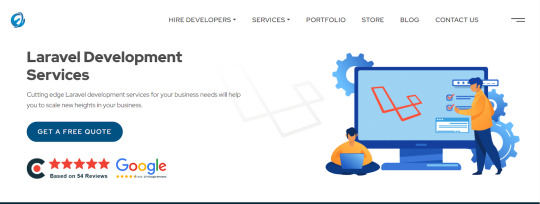
Elsner Technologies is a Laravel development company that has gained a high level of expertise in Laravel, one of the most popular PHP-based frameworks available in the market today. With the help of their Laravel Web Development services, you can expect both professional and highly imaginative web and mobile applications.
Additional Information-
GoodFirms : 5
Avg. hourly rate: < $25/hr
No. Employee: 250 - 999
Founded Year : 2006
Logicspice

Logicspice stands as an expert and professional Laravel web development service provider, catering to enterprises of diverse scales and industries. Leveraging the prowess of Laravel, an open-source PHP framework renowned for its ability to expedite the creation of secure, scalable, and feature-rich web applications.
Additional Information-
GoodFirms : 5
Avg. hourly rate: < $25/hr
No. Employee: 50 - 249
Founded Year : 2006
Sapphire Software Solutions
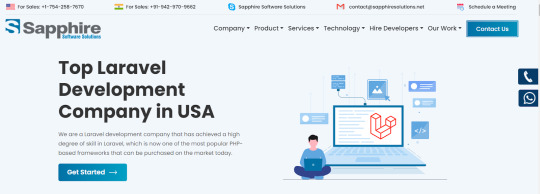
Sapphire Software Solutions, a leading Laravel development company in the USA, specialises in customised Laravel development, enterprise solutions,.With a reputation for excellence, they deliver top-notch services tailored to meet your unique business needs.
Additional Information-
GoodFirms : 5
Avg. hourly rate: NA
No. Employee: 50 - 249
Founded Year : 2002
iGex Solutions
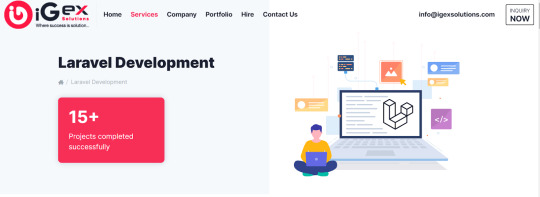
iGex Solutions offers the World’s Best Laravel Development Services with 14+ years of Industry Experience. They have 10+ Laravel Developer Experts. 100+ Elite Happy Clients from there Services. 100% Client Satisfaction Services with Affordable Laravel Development Cost.
Additional Information-
GoodFirms : 4.7
Avg. hourly rate: < $25/hr
No. Employee: 10 - 49
Founded Year : 2009
Hidden Brains
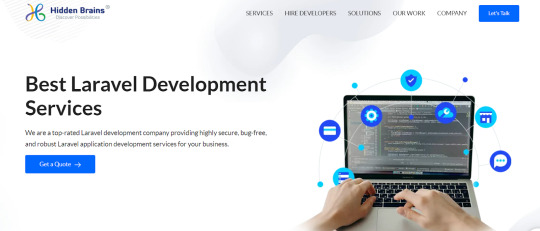
Hidden Brains is a leading Laravel web development company, building high-performance Laravel applications using the advantage of Laravel's framework features. As a reputed Laravel application development company, they believe your web application should accomplish the goals and can stay ahead of the rest.
Additional Information-
GoodFirms : 4.9
Avg. hourly rate: < $25/hr
No. Employee: 250 - 999
Founded Year : 2003
Matellio
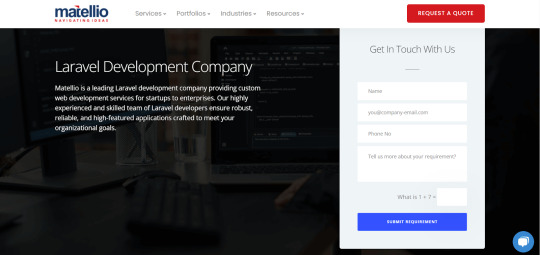
At Matellio, They offer a wide range of custom Laravel web development services to meet the unique needs of their global clientele. There expert Laravel developers have extensive experience creating robust, reliable, and feature-rich applications
Additional Information-
GoodFirms : 4.8
Avg. hourly rate: $50 - $99/hr
No. Employee: 50 - 249
Founded Year : 2014
What advantages does Laravel offer for your web application development?
Laravel, a popular PHP framework, offers several advantages for web application development:
Elegant Syntax
Modular Packaging
MVC Architecture Support
Database Migration System
Blade Templating Engine
Authentication and Authorization
Artisan Console
Testing Support
Community and Documentation
Conclusion:
I hope you found the information provided in the article to be enlightening and that it offered valuable insights into the top Laravel development companies.
These reputable Laravel development companies have a proven track record of creating customised solutions for various sectors, meeting client requirements with precision.
Over time, these highlighted Laravel developers for hire have completed numerous projects with success and are well-equipped to help advance your business.
Before finalising your choice of a Laravel web development partner, it is essential to request a detailed cost estimate and carefully examine their portfolio of past work.
#Laravel Development Companies#Laravel Development Companies in USA#Laravel Development Company#Laravel Web Development Companies#Laravel Web Development Services
2 notes
·
View notes
Text
Platform as a Service (PaaS)

Platform as a Service (PaaS) is a cloud computing service model that provides a platform allowing customers to develop, run, and manage applications without the complexity of building and maintaining the underlying infrastructure. PaaS provides a comprehensive environment that includes development tools, middleware, and runtime services to streamline the application development and deployment process. Here are key features and aspects of PaaS:
Key Features of PaaS:
Development Tools:
PaaS offers a set of tools and services for application development, including integrated development environments (IDEs), version control, and testing frameworks.
Middleware:
PaaS includes middleware services that facilitate communication and integration between different components of an application. This can include databases, messaging systems, and more.
Runtime Services:
PaaS provides runtime services such as operating systems, web servers, and runtime environments. Developers can focus on writing code without worrying about the underlying infrastructure.
Scalability:
PaaS platforms typically offer automatic scaling to handle changes in application demand. This ensures that resources are allocated efficiently, and the application can handle varying workloads.
Multi-Tenancy:
PaaS platforms often support multi-tenancy, allowing multiple users or organizations to share the same infrastructure and resources while maintaining isolation.
Integration with Services:
PaaS allows integration with various external services, such as databases, messaging systems, authentication services, and more, to enhance the functionality of applications.
Deployment and Management:
PaaS simplifies the deployment process, offering tools for application deployment, version control, and monitoring. It often includes management tools for application lifecycle management.
Advantages of PaaS:
Faster Development:
PaaS accelerates the development process by providing pre-built tools and services, reducing the need for developers to manage infrastructure details.
Cost Efficiency:
Developers can focus on coding, while the PaaS provider handles infrastructure maintenance and management, leading to cost savings.
Scalability and Flexibility:
PaaS platforms enable easy scaling of applications based on demand, providing flexibility to handle varying workloads.
Reduced Complexity:
Developers don't need to worry about managing the underlying infrastructure, operating systems, or runtime environments, reducing complexity and allowing them to focus on writing code.
Collaboration:
PaaS facilitates collaboration among development teams, as they can work on the same platform and easily share resources.
Automatic Updates:
PaaS providers handle updates and patches for underlying software, ensuring that the platform is up-to-date and secure.
Resource Optimization:
PaaS platforms optimize resource usage, allocating resources based on application requirements to avoid overprovisioning.
Rapid Prototyping:
Developers can quickly prototype and experiment with ideas without the need to set up and configure infrastructure.
Cloud computing training course in Pune
3 notes
·
View notes
Text
Workflow AI Automation: Revolutionizing Business Processes
In today's rapidly evolving technological landscape, businesses are continually seeking innovative solutions to enhance efficiency, reduce operational costs, and maintain a competitive edge. One such groundbreaking advancement is Workflow AI Automation, which integrates artificial intelligence into business workflows to automate complex tasks, streamline operations, and foster intelligent decision-making. This article delves into the technical aspects of Workflow AI Automation, exploring its components, benefits, implementation strategies, and future trends.
Understanding Workflow AI Automation
Workflow AI Automation refers to the use of artificial intelligence technologies to automate and optimize business processes that traditionally require human intervention. Unlike conventional automation, which relies on predefined rules and scripts, AI-driven automation leverages machine learning, natural language processing, and cognitive computing to adapt to dynamic conditions, learn from data, and make informed decisions.
Key Components of Workflow AI Automation
Artificial Intelligence (AI): The core of this automation, encompassing machine learning algorithms, natural language processing, and computer vision to interpret data, recognize patterns, and execute tasks autonomously.
Robotic Process Automation (RPA): Software robots that mimic human actions to perform repetitive tasks across applications, such as data entry, transaction processing, and report generation.
Integration Platforms: Middleware solutions that facilitate seamless communication between AI systems and existing enterprise applications, ensuring cohesive workflow execution.
Data Management Systems: Tools and frameworks that handle data collection, storage, processing, and analysis, providing the necessary information for AI models to function effectively.
Benefits of Implementing Workflow AI Automation
Enhanced Operational Efficiency: By automating routine tasks, businesses can significantly reduce processing times and minimize errors, leading to improved productivity.
Scalability: AI-driven automation systems can easily scale to accommodate increasing workloads without a proportional increase in operational costs.
Improved Accuracy and Compliance: Automation ensures consistent adherence to regulatory standards and internal policies, reducing the risk of non-compliance.
Cost Reduction: Decreasing reliance on manual labor for repetitive tasks leads to substantial cost savings in the long term.
Data-Driven Insights: AI systems analyze vast amounts of data to provide actionable insights, facilitating informed decision-making and strategic planning.
Implementing Workflow AI Automation: A Technical Approach
Process Identification and Analysis:
Task Mapping: Identify and document existing workflows to determine which processes are suitable for automation.
Feasibility Assessment: Evaluate the complexity, frequency, and variability of tasks to prioritize automation efforts.
Selecting the Right Tools and Technologies:
AI Platforms: Choose AI frameworks and tools that align with business objectives and technical requirements.
RPA Solutions: Select RPA software capable of integrating with current systems and handling the desired tasks.
Integration and Development:
System Integration: Develop APIs and connectors to enable communication between AI models, RPA bots, and existing applications.
Workflow Design: Utilize process orchestration tools to design and simulate automated workflows before deployment.
Testing and Validation:
Pilot Programs: Implement automation in a controlled environment to monitor performance and identify potential issues.
Quality Assurance: Conduct rigorous testing to ensure accuracy, reliability, and compliance with regulatory standards.
Deployment and Monitoring:
Rollout Strategy: Gradually deploy automated workflows, starting with high-impact areas to demonstrate value.
Continuous Monitoring: Establish monitoring systems to track performance metrics, detect anomalies, and facilitate ongoing optimization.
Challenges and Considerations
Data Security and Privacy: Ensuring that AI systems comply with data protection regulations and safeguard sensitive information is paramount.
Change Management: Preparing the workforce for automation through training and clear communication helps in mitigating resistance and promoting acceptance.
Technical Complexity: Integrating AI into existing systems requires specialized expertise and a thorough understanding of both the technological and business landscapes.
Ethical Implications: Establishing guidelines to address ethical concerns, such as bias in AI decision-making, is essential for responsible implementation.
Future Trends in Workflow AI Automation
Hyperautomation: The combination of AI, RPA, and other advanced technologies to automate complex end-to-end business processes.
Intelligent Process Discovery: Utilizing AI to analyze workflows and identify additional automation opportunities autonomously.
AI-Augmented Workforce: Collaborative environments where human workers and AI systems work in tandem, enhancing overall productivity and innovation.
Edge AI Automation: Deploying AI capabilities at the edge of networks to enable real-time processing and automation in IoT devices and remote locations.
Conclusion
Workflow AI Automation stands at the forefront of technological innovation, offering businesses the tools to transform their operations, enhance efficiency, and drive growth. By thoughtfully implementing AI-driven automation, organizations can navigate the complexities of modern markets, adapt to evolving demands, and secure a competitive advantage in their respective industries.
0 notes
Text
Best IICS in Hyderabad | Informatica Cloud Training
The Role of Service Connectors in CAI (Conversational AI)
Introduction
Conversational AI (CAI) is transforming the way businesses interact with users through chatbots, virtual assistants, and voice-driven interfaces. One of the most critical components of CAI systems is Service Connectors, which enable seamless integration between AI-driven interfaces and external services, databases, and APIs. These connectors ensure that CAI solutions provide accurate, real-time responses while enhancing automation and user experience. Informatica Cloud Training
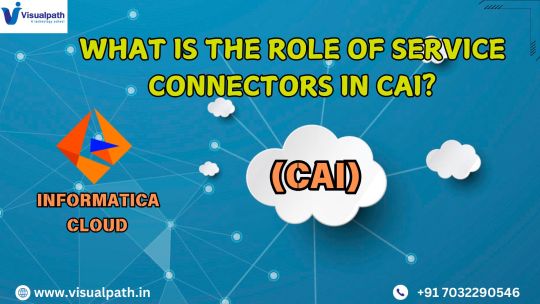
What Are Service Connectors in CAI?
Service Connectors are middleware components that facilitate communication between CAI platforms and external data sources, enterprise applications, and third-party APIs. They act as bridges, ensuring that AI-powered assistants can fetch and process relevant data dynamically. Without service connectors, conversational AI systems would be limited to static responses and cannot interact meaningfully with users.
Key Functions of Service Connectors
Data Retrieval & Processing: Service connectors enable CAI systems to fetch real-time data from CRM, ERP, or other databases to provide up-to-date responses to user queries.
API Integration: They allow chatbots to interact with various APIs, including payment gateways, weather services, and customer support platforms, to deliver multi-functional assistance.
Automation & Workflow Execution: Service connectors facilitate automated workflows by triggering actions based on user requests, such as booking appointments or processing orders. Informatica IICS Training
Security & Compliance: They ensure secure data transactions by enforcing authentication, encryption, and compliance with industry regulations like GDPR and HIPAA.
Personalization & Context Awareness: By integrating with user profiles, purchase history, and past interactions, service connectors help conversational AI systems deliver personalized experiences.
How Service Connectors Enhance CAI Performance
1. Real-time Data Access
Service connectors ensure that AI-driven conversations are not static but dynamic. For instance, a customer asking about their order status can receive real-time updates because the chatbot retrieves information from the company's order management system.
2. Seamless Omnichannel Experience
Many businesses operate across multiple platforms, including web, mobile apps, and social media. Service connectors enable CAI systems to provide consistent interactions across all these channels by syncing data from different sources. Informatica Training Online
3. Enhanced Customer Support
By integrating with ticketing systems, helpdesk software, and knowledge bases, service connectors allow AI chatbots to offer immediate and relevant solutions to customer inquiries. This reduces the workload on human agents and improves response efficiency.
4. Increased Efficiency Through Automation
Service connectors play a vital role in automating business processes. For example, a banking chatbot can automate balance inquiries, fund transfers, and loan application processes by connecting with banking APIs securely.
5. Scalability and Flexibility
With service connectors, CAI solutions can scale effortlessly. Businesses can integrate new services, expand functionalities, and upgrade existing workflows without redesigning the entire AI infrastructure.
Common Use Cases of Service Connectors in CAI
E-commerce: AI chatbots integrate with inventory databases and payment gateways to assist customers with product availability, order tracking, and payments. Informatica Cloud Training Institute
Healthcare: Virtual assistants retrieve patient records from Electronic Health Records (EHR) systems to schedule appointments and provide health advice.
Banking & Finance: AI bots connect to financial systems to enable balance inquiries, fraud detection, and transaction alerts
Customer Service: Service connectors link AI assistants with CRM platforms to provide personalized support and escalate complex issues to human agents.
Conclusion
Service connectors are an essential component of modern Conversational AI (CAI) solutions, enabling them to interact with external services, retrieve data dynamically, and automate workflows efficiently. By integrating service connectors, businesses can enhance customer engagement, streamline operations, and provide intelligent, real-time assistance. As CAI technology continues to evolve, the role of service connectors will become even more crucial in building smarter and more responsive AI-driven communication systems.
For More Information about Informatica Cloud Online Training
Contact Call/WhatsApp: +91 7032290546
Visit: https://www.visualpath.in/informatica-cloud-training-in-hyderabad.html
#Informatica Training in Hyderabad#IICS Training in Hyderabad#IICS Online Training#Informatica Cloud Training#Informatica Cloud Online Training#Informatica IICS Training#Informatica Training Online#Informatica Cloud Training in Chennai#Informatica Cloud Training In Bangalore#Best Informatica Cloud Training in India#Informatica Cloud Training Institute#Informatica Cloud Training in Ameerpet
0 notes
Text
React Middleware: Bridging APIs and Components
http://securitytc.com/THyHy1
0 notes
Text
How Proxies Enhance Traffic Flow and Optimize Load Balancing
With the rapid development of information technology and the deepening of digital transformation, network applications and services are facing unprecedented traffic challenges. In order to ensure the high availability, scalability and performance optimization of the system, load balancing and traffic distribution have become crucial technical issues. As a mature and efficient network middleware, proxy has demonstrated excellent ability in solving these problems with its unique forwarding, distribution and caching mechanisms. This article aims to explore in depth how proxy plays a core role in load balancing and traffic distribution, and analyze its technical principles, application advantages and practical scenarios.
Overview and functional analysis of proxy technology
As a key component in network communication, proxy plays the role of a bridge between the client and the target server. It can not only receive and forward client requests to the target server, but also filter, cache, encrypt, compress and other processing of requests. These functions lay a solid foundation for the application of proxy in load balancing and traffic distribution.
1. Request forwarding and distribution
One of the core functions of the proxy is request forwarding and distribution. It can intelligently distribute client requests to multiple background servers according to preset rules and algorithms, thereby achieving balanced distribution of requests.
2. Content caching and acceleration
Proxy servers usually have built-in caching mechanisms that can cache frequently accessed content or data. When a client initiates a request, the proxy first checks whether the corresponding content exists in the cache. If it exists, the cached content is returned directly without sending a request to the backend server, thereby significantly improving the response speed and reducing the backend server load.
3. Request filtering and security protection
The proxy can also filter and preprocess requests, effectively intercept invalid, malicious or non-compliant requests, and provide a layer of security protection for the backend server.
The urgency and challenges of load balancing
As a key technology in distributed systems and high-concurrency scenarios, load balancing aims to improve the overall processing power and response speed of the system through reasonable resource allocation. However, with the expansion of user scale and the increase in business complexity, load balancing faces many challenges, such as server performance differences, network delays, single point failures, etc. If these problems are not effectively solved, they will seriously affect the stability and availability of the system.
The core role of proxy in load balancing and traffic dispersion
1. Intelligent request distribution mechanism
By implementing a variety of intelligent request distribution mechanisms (such as polling, random, weight, consistent hashing, etc.), the proxy can dynamically adjust the request distribution ratio according to the server's real-time load, processing capacity, response speed and other factors. This mechanism ensures that each server can receive an appropriate amount of requests, avoiding single-point overload and resource waste.
2. Efficient content caching and acceleration strategy
The proxy's content caching and acceleration strategy plays a vital role in load balancing. By caching frequently accessed content, the proxy can significantly reduce the number of requests to the backend server and reduce its load pressure. At the same time, the rapid response of cached content also greatly improves the user experience.
3. Powerful request filtering and security protection capabilities
The proxy's request filtering and security protection capabilities provide strong protection for the backend server. It can intercept and process invalid, malicious or non-compliant requests to prevent these requests from interfering with or damaging the backend server. This mechanism not only improves the security of the system, but also reduces the processing burden of the backend server.
4. Flexible dynamic adjustment and failover strategy
The proxy server can monitor the status of the background server in real time and make dynamic adjustments according to the actual situation. When a server fails or fails to respond, the proxy can quickly transfer the request to other available servers to ensure the continuity and availability of the service. This failover mechanism greatly improves the fault tolerance and stability of the system.
Application scenarios of proxy in load balancing and traffic distribution
1. Large websites and e-commerce platforms
For large websites and e-commerce platforms, proxy technology is an important means to achieve load balancing and traffic distribution. It can help these platforms cope with the challenges of high concurrent access and massive data processing, and ensure the stability and availability of services.
2. Cloud computing and data center environment
In cloud computing and data center environments, proxy technology can achieve cross-regional and cross-data center traffic distribution and load balancing. Through intelligent routing selection and traffic scheduling mechanisms, it can ensure that data is efficiently and evenly transmitted and processed between multiple data centers.
3. Microservice architecture and distributed systems
Proxy technology also plays an important role in microservice architecture and distributed systems. It can help achieve load balancing and traffic dispersion between services, and improve the overall processing capacity and response speed of the system. At the same time, the proxy's failover and fault tolerance mechanism also provide a strong guarantee for the stability and reliability of the system.
Conclusion
In summary, proxy technology plays a core role in load balancing and traffic dispersion. It provides a stable, efficient and secure operating environment for network applications and services through intelligent request distribution mechanism, efficient content caching and acceleration strategy, powerful request filtering and security protection capabilities, and flexible dynamic adjustment and failover strategy.
0 notes
Text
Embedded Software Development Services
Embedded software development plays a crucial role in modern technology, powering devices across industries such as healthcare, automotive, consumer electronics, and industrial automation. Unlike software, embedded systems are designed for specific hardware, ensuring optimal performance, and reliability. Companies like EmbedTech Solutions, a leading embedded software development company, specialize in providing embedded software development services tailored to industry needs.
Understanding Embedded Software
Embedded software is a specialized program that runs on microcontrollers, microprocessors, or other integrated circuits. It is responsible for executing tasks within an embedded system, such as processing data from sensors, controlling actuators, or managing communication protocols. Since these systems often function in real-time environments, they require optimized, stable, and efficient code. High-quality embedded software design in india ensures that the system meets performance and reliability standards.
Key Components of Embedded Systems
Every embedded system consists of both hardware and software elements that work together to achieve its intended functionality. Hardware components include microcontrollers (MCUs), microprocessors (MPUs), sensors, actuators, and memory (RAM, Flash). The choice of hardware directly influences software performance. On the software side, embedded systems rely on firmware, operating systems (RTOS or bare metal), device drivers, and middleware. C, C++, and Python are among the most commonly used programming languages in this field. EmbedTech Solutions specializes in embedded system design services in india, integrating these components to develop high-performance embedded systems.
Development Stages of Embedded Software
Developing embedded software involves a structured process to ensure efficiency, reliability, and scalability. The first step is embedded software design in india, where functional and performance requirements are defined, considering hardware constraints and expected workloads. System design follows, during which engineers create the software architecture, determining how different components interact and ensuring compatibility with the hardware. The coding and implementation stage involves writing optimized, resource-efficient code to handle real-time tasks and meet performance expectations. embedded software testing in india is a crucial step to verify stability and accuracy, using simulators, hardware debuggers, and real-world trials.
Challenges in Embedded Software Development
Embedded software development comes with unique challenges that require specialized solutions. Limited memory and processing power demand efficient and optimized code, making resource constraints a significant challenge. Many embedded systems require immediate responses, necessitating precise timing and scheduling to handle real-time processing needs. Security and reliability are crucial, especially in critical applications like medical devices and automotive control systems, where robust security and fail-safe mechanisms are essential. embedded system integration in india is another challenge, as smooth communication between components is necessary for system stability and overall performance.
embedded software development services in india are fundamental to technological innovation, enabling smart devices, automation, and IoT applications. With growing advancements in AI, connectivity, and real-time processing, embedded systems will continue to shape the future of multiple industries. Companies like EmbedTech Solutions provide expert embedded software services in india, delivering high-quality solutions tailored to industry demands. Developers must focus on efficiency, security, and embedded software testing in india to build reliable and scalable embedded solutions.
0 notes
Text
Real-Time Supplier Risk Assessment in eProcurement Systems
In today's high-speed business world, the success of procurement depends on indispensable supplier risk management. While most companies leverage eProcurement software to simplify operations, real-time risk monitoring has often been ignored, which has resulted in expensive disruptions. With real-time supplier risk management, such risks are minimized, ensuring continuity in the supply chain.
It will use AI, blockchain, and data analytics to track supplier performance, monitor shipments, and spot potential disruptions. As supply chains become increasingly complex, traditional risk management methods will no longer suffice. Real-time monitoring allows a business to foresee and proactively deal with the risks.
The key components of the system include a unified supplier record, multi-dimensional risk analytics, supplier scorecards, and automated refreshes of data. Real-time alerts notify teams of critical risk changes for timely action. Issue tracking and continuous monitoring further strengthen supplier oversight.
Integration of risk management tools with eProcurement systems enables visibility, reduces response time, and increases compliance. Seamless API or middleware integration ensures the automation of data exchange, thus offering real accurate, timely risk assessments.
Automated risk monitoring is of great importance when it comes to supplier management. Real-time data feeds, easily configurable risk-scoring models, and alert mechanisms will drive proactive decision-making. Such tools enable businesses to respond swiftly to supplier issues, reducing disruptions and driving efficiency accordingly.
By implementing real-time supplier risk management, organizations ensure better procurement, stronger relationships with suppliers, and long-term resilience in their supply chains. Given the rising risks across global supply chains, real-time monitoring solutions are crucial investments to be made for the protection of business continuity and financial stability.
0 notes
Text
How to Integrate Embedded Software with Existing IT Infrastructure
Integrating embedded software with existing IT infrastructure is a complex yet crucial process for businesses looking to enhance operational efficiency, streamline data processing, and optimize device functionality. With the rapid growth of IoT, automation, and AI-driven solutions, embedded systems have become an integral part of modern enterprises. However, seamless integration requires careful planning, technical expertise, and a strategic approach to ensure compatibility, security, and performance.
In this article, we will explore the essential steps to successfully integrate embedded software into an organization’s IT ecosystem. From assessing compatibility requirements to implementing robust security measures, we’ll provide a comprehensive guide to help businesses navigate this process effectively.
1. Understanding the Compatibility Requirements
Before integrating embedded software into existing IT infrastructure, organizations must assess compatibility across multiple dimensions, including hardware, software, and network configurations.
Assessing Existing IT Infrastructure
Conduct a thorough audit of the current IT environment, including servers, databases, cloud platforms, and network architecture.
Identify potential bottlenecks or constraints that could impact the integration process.
Determine the computing resources available to support embedded systems, such as processing power, memory, and storage.
Identifying Integration Challenges
Legacy systems may lack the necessary APIs or connectivity options to support modern embedded software.
Embedded devices often operate on real-time operating systems (RTOS), which may require specific protocols to communicate with traditional IT systems.
Hardware limitations could restrict the performance of embedded applications, necessitating hardware upgrades.
Ensuring Security and Compliance
Regulatory requirements such as GDPR, HIPAA, or industry-specific standards must be considered when integrating embedded software.
Data encryption, secure authentication, and access controls should be implemented to protect sensitive information.
Compliance with cybersecurity best practices ensures that embedded systems do not become potential vulnerabilities within the IT network.
2. Choosing the Right Embedded Software Development Approach
Selecting the right development strategy is key to ensuring seamless integration and long-term sustainability. Businesses can choose between custom-built or off-the-shelf solutions based on their needs.
Custom vs. Off-the-Shelf Solutions
Custom Embedded Software: Tailored solutions designed to meet specific business requirements, offering greater flexibility and scalability.
Off-the-Shelf Solutions: Pre-built software that may require modifications but provides a faster implementation timeline.
The Role of an Embedded Software Development Company
A professional embedded software development company can offer expertise in designing and optimizing solutions for complex IT environments. Their experience ensures that integration challenges are minimized, and system performance is optimized for business operations.
Scalability and Future-Proofing
The chosen software should be scalable to accommodate future expansions and technology upgrades.
Integration with cloud services and IoT platforms can enhance flexibility and improve long-term efficiency.
3. Ensuring Seamless Data Communication
For embedded software to function efficiently within an IT infrastructure, seamless data exchange is essential. This requires robust middleware solutions, communication protocols, and real-time synchronization mechanisms.
Implementing Middleware and APIs
Middleware acts as a bridge between embedded systems and enterprise applications, enabling smooth data flow. APIs (Application Programming Interfaces) facilitate secure and structured interactions between software components.
Industry-Standard Communication Protocols
MQTT (Message Queuing Telemetry Transport): Ideal for IoT and real-time applications due to its lightweight and efficient messaging system.
CAN (Controller Area Network): Used in automotive and industrial applications for communication between embedded systems.
Modbus & OPC-UA: Commonly employed in industrial automation for seamless interoperability between devices.
Synchronization Between Embedded Systems and IT Applications
Embedded devices should sync with IT databases and cloud storage to ensure data consistency.
Real-time processing and edge computing solutions can reduce latency and enhance performance.
4. Addressing Cybersecurity Challenges
Security is a major concern when integrating embedded software into IT infrastructure, as these systems can be vulnerable to cyber threats if not properly protected.
Common Security Risks
Unauthorized access and data breaches
Firmware vulnerabilities leading to system compromise
Network attacks targeting connected embedded devices
Best Practices for Secure Integration
Implement secure boot mechanisms to ensure that only trusted firmware and applications run on embedded devices.
Use end-to-end encryption for data transmission between embedded systems and IT infrastructure.
Regularly update firmware and software patches to mitigate security vulnerabilities.
Employ role-based access control (RBAC) to restrict system access based on user roles.
Regulatory Compliance and Security Standards
Organizations must align with industry security standards such as:
ISO/IEC 27001 for information security management
NIST Cybersecurity Framework for Risk Management
IEC 62443 for industrial control system security
5. Testing and Performance Optimization
Before fully deploying embedded software, rigorous testing and performance benchmarking must be conducted to ensure smooth operation.
System Testing Before Deployment
Functional testing to verify core features and capabilities
Compatibility testing with existing IT infrastructure
Load and stress testing to evaluate performance under high-demand
Performance Benchmarking and Debugging
Use profiling tools to analyze software efficiency and optimize execution times.
Debugging techniques such as logging, tracing, and simulation help identify and resolve issues before deployment.
Continuous Monitoring and Maintenance
Implement remote monitoring solutions to track device health and performance.
Use predictive maintenance techniques powered by AI and machine learning to prevent system failures.
Conclusion
Integrating embedded software with existing IT infrastructure is a critical step for businesses aiming to improve operational efficiency, enhance security, and scale their technology stack. By assessing compatibility, selecting the right development approach, ensuring seamless data communication, and addressing cybersecurity risks, organizations can achieve a successful integration.
Partnering with an experienced embedded software development company can streamline this process and mitigate potential challenges. With proper planning, testing, and continuous optimization, businesses can maximize the benefits of embedded software while maintaining a secure and efficient IT ecosystem.
0 notes
Text
A demo web app from an experienced developer. Highlights: somplicty (routing - cond, minimal middleware, no component framework), 1st class DB queries.
0 notes
Text
RFID in Supply Chain Management: Enhancing Efficiency and Security
The global radio frequency identification (RFID) technology market size was estimated at USD 15,769.8 million in 2022 and is expected to grow at a compound annual growth rate (CAGR) of 15.1% from 2023 to 2030. The market is poised to witness steady growth over the forecast period due to the growing demand for asset tracking, inventory management, resource optimization, and monitoring assets of security and safety. Moreover, the proliferation of Real Time Location Systems (RTLS), sensor networks, 5G, and the Internet of Things (IoT) has made RFID devices more significant in the connected world. RFID devices are anticipated to be increasingly important in capitalizing on these technologies, contributing to the market’s growing demand.
The RFID systems that are deployed in the market are composed of three major components, namely tags, readers, and middleware. The RFID tags form the largest part of the market and are subject to prime development activities. While the deployment of passive tags is the largest in the industry, active tags are also gaining momentum as numerous new applications have sprung up in recent years, and the tag size has persistently been reducing. The growth of the market can also be attributed to the benefits provided by RFID tags, including identifying objects without being in direct line of sight, the ability to scan objects from a large distance, real-time data updates, and less than 100 milliseconds per tag reading time.
The significant trends aiding in adopting RFID technology are automation, supply chain management, real-time intelligence, asset tracking & payments, and NFC. The government mandates for using RFID tags for tracking various industry products, such as defense, livestock, and data centers, are also essential factors in the industry’s development. Moreover, technological advancements in UHF technology, the convergence of RFID with other communication technologies, and the growth in semi-passive and printed tags are anticipated to drive market growth in the coming years.
Radio Frequency Identification Technology Market Segmentation
The report forecasts revenue growth at global, regional, and country levels and provides an analysis of the latest trends in each of the sub-segments from 2017 to 2030. For this study, Grand View Research has segmented the global radio frequency identification technology market report based on component, system, frequency, application, and region:
Component Outlook (Revenue, USD Million, 2017 - 2030)
Tags
Antennas
Readers
Middleware
System Outlook (Revenue, USD Million, 2017 - 2030)
Active RFID System
Passive RFID System
Frequency Outlook (Revenue, USD Million, 2017 - 2030)
Low Frequency (LF) RFID
High Frequency (HF) RFID
Ultra-high Frequency (UHF) RFID
Application Outlook (Revenue, USD Million, 2017 - 2030)
Retail
Financial Services
Healthcare
Industrial
Government
Transportation & Logistics
Others
Regional Outlook (Revenue, USD Million, 2017 - 2030)
North America
US
Canada
Europe
UK
Germany
France
Asia Pacific
China
India
Japan
South Korea
Australia
Latin America
Brazil
Mexico
Middle East & Africa
Kingdom of Saudi Arabia (KSA)
UAE
South Africa
Key Company Insights
January 2023, MishiPay Ltd. announced the launch of its new RFID self-checkout kiosk. The kiosk utilizes RFID sensors, enabling customers to scan and remit payment for items without requiring the scanning of each item's barcode.
Key Players
Honeywell International Inc.
Zebra Technologies Corp.
Avery Dennison Corp.
Nedap
Impinj, Inc.
NXP Semiconductors
Unitech Electronics Co., Ltd.
HID Global Corp.
Invengo Information Technology Co., Ltd.
Datalogic SpA
Order a free sample PDF of the Radio Frequency Identification Technology Market Intelligence Study, published by Grand View Research.
0 notes
Text
Laravel customized portal development services
Cost-Effective Laravel Solutions for Developing Bespoke Portals for Small Businesses Laravel offers an exceptional framework for small businesses seeking cost-effective web application development. The open-source nature of Laravel provides a significant financial advantage, eliminating expensive licensing fees that can burden small enterprises1. Developers can leverage the framework's robust ecosystem to create custom portals without incurring substantial upfront costs. The cost-effectiveness of Laravel stems from multiple strategic advantages. Its Eloquent Object-Relational Mapping (ORM) dramatically reduces development time by simplifying database interactions. This efficiency translates directly into lower development expenses, as developers can create complex database-driven portals more quickly and with less manual coding. Small businesses can benefit from reduced labor costs and faster time-to-market for their custom web applications. Modular Development Approach Laravel's modular packaging system is a game-changer for cost-conscious businesses. The framework enables developers to create reusable, independent components that can be easily integrated into different projects. This modularity means small businesses can: Reduce custom coding expenses Leverage pre-built modules Scale their portals incrementally Minimize long-term development costs Security and Maintenance Contrary to popular belief, cost-effective solutions don't mean compromising on security. Laravel provides built-in security features like hashed passwords, protection against SQL injection, and cross-site scripting prevention. These integrated security measures save businesses the additional expense of implementing custom security protocols. Creating Multi-Tenant Custom Portals with Laravel: A Guide for Developers Multi-tenant portal development requires a sophisticated approach to resource sharing and data isolation. Laravel's architecture provides robust mechanisms for creating scalable, secure multi-tenant solutions. Developers can implement tenant isolation through: Shared Database Strategies: Utilizing separate schema or table prefixes Middleware-Based Tenant Routing Efficient Resource Management The framework's authentication and authorization systems make it straightforward to implement granular access controls. Developers can create complex permission structures that ensure each tenant only accesses their designated resources. How Laravel's Modular Approach Benefits Customized Portal Development Laravel's modular structure is a powerful tool for creating flexible web applications. The framework's package system allows developers to: Rapidly Prototype: Quickly add or remove components Maintain Clean Code Architecture Enhance Scalability Reduce Technical Debt Developers can leverage packages from the extensive Laravel ecosystem, reducing development time and costs. The ability to integrate third-party services seamlessly means businesses can extend portal functionality without extensive custom development. Cost Considerations For smaller business concerns, the development in a country like India can be very cost-effective for Laravel. For a basic complex project, the development cost would range between 15,000 to 50,000 INR. The hourly rates available for Laravel developers would go from $25 to $150. The offshore development might offer additional savings. By embracing Laravel's open-source nature, modular design, and robust ecosystem, small businesses can develop powerful, scalable portals without breaking the bank. The framework provides a perfect balance of flexibility, security, and cost-efficiency for custom web application development.
0 notes